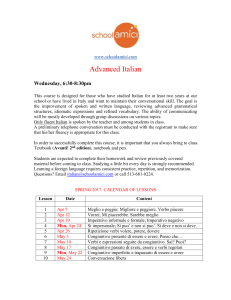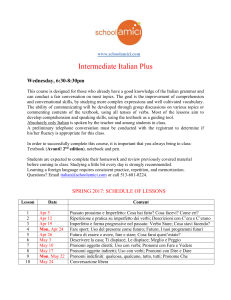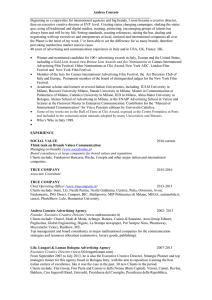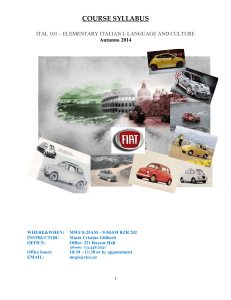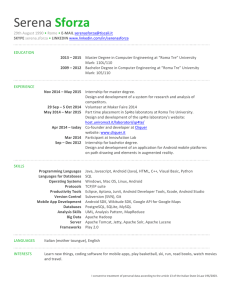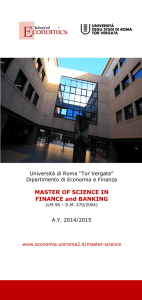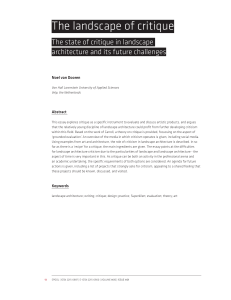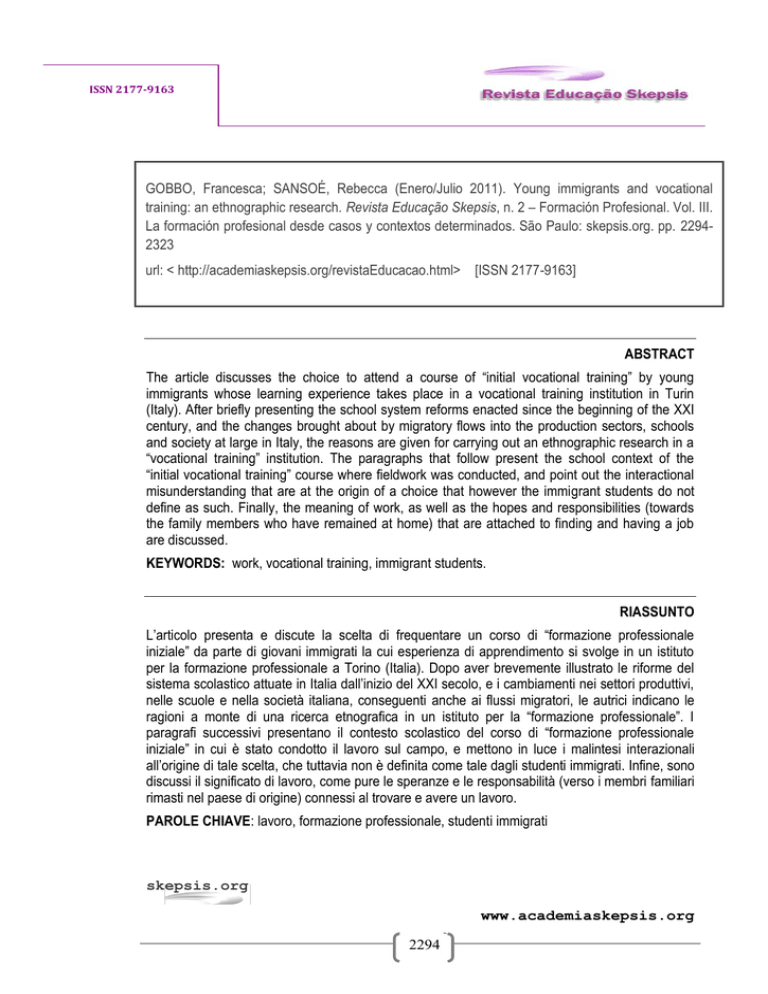
ISSN 2177-9163
GOBBO, Francesca; SANSOÉ, Rebecca (Enero/Julio 2011). Young immigrants and vocational
training: an ethnographic research. Revista Educação Skepsis, n. 2 – Formación Profesional. Vol. III.
La formación profesional desde casos y contextos determinados. São Paulo: skepsis.org. pp. 22942323
url: < http://academiaskepsis.org/revistaEducacao.html> [ISSN 2177-9163]
ABSTRACT
The article discusses the choice to attend a course of “initial vocational training” by young
immigrants whose learning experience takes place in a vocational training institution in Turin
(Italy). After briefly presenting the school system reforms enacted since the beginning of the XXI
century, and the changes brought about by migratory flows into the production sectors, schools
and society at large in Italy, the reasons are given for carrying out an ethnographic research in a
“vocational training” institution. The paragraphs that follow present the school context of the
“initial vocational training” course where fieldwork was conducted, and point out the interactional
misunderstanding that are at the origin of a choice that however the immigrant students do not
define as such. Finally, the meaning of work, as well as the hopes and responsibilities (towards
the family members who have remained at home) that are attached to finding and having a job
are discussed.
KEYWORDS: work, vocational training, immigrant students.
RIASSUNTO
L’articolo presenta e discute la scelta di frequentare un corso di “formazione professionale
iniziale” da parte di giovani immigrati la cui esperienza di apprendimento si svolge in un istituto
per la formazione professionale a Torino (Italia). Dopo aver brevemente illustrato le riforme del
sistema scolastico attuate in Italia dall’inizio del XXI secolo, e i cambiamenti nei settori produttivi,
nelle scuole e nella società italiana, conseguenti anche ai flussi migratori, le autrici indicano le
ragioni a monte di una ricerca etnografica in un istituto per la “formazione professionale”. I
paragrafi successivi presentano il contesto scolastico del corso di “formazione professionale
iniziale” in cui è stato condotto il lavoro sul campo, e mettono in luce i malintesi interazionali
all’origine di tale scelta, che tuttavia non è definita come tale dagli studenti immigrati. Infine, sono
discussi il significato di lavoro, come pure le speranze e le responsabilità (verso i membri familiari
rimasti nel paese di origine) connessi al trovare e avere un lavoro.
PAROLE CHIAVE: lavoro, formazione professionale, studenti immigrati
skepsis.org
www.academiaskepsis.org
229
2294
4
ISSN 2177-9163
skepsis.org
www.academiaskepsis.org
229
2295
5
ISSN 2177-9163
YOUNG IMMIGRANTS AND VOCATIONAL TRAINING:
AN ETHNOGRAPHIC RESEARCH
GIOVANI IMMIGRATI E FORMAZIONE PROFESSIONALE:
UNA RICERCA ETNOGRAFICA
Francesca Gobbo1
Rebecca Sansoé 2
INTRODUCTION
When the senior author of this article received the invitation to
write for the Journal Skepsis Education’s special issue on “The
vocational training from the perspective of specific cases and
contexts", she suggested that the contribution could present and
discuss the findings of a recently completed doctoral research in
ethnography of education that she had coordinated and that had been
carried out by Rebecca Sansoé. So far, it is one of the few qualitative
researches concerning what by official definition is known as “initial
vocational training”.3
Francesca Gobbo, Professor of Intercultural Education at the University of Turin, is author of the
introduction, paragraph 1 and the conclusion. Corresponding address: [email protected]
1
Rebecca Sansoé, PhD in Educational Sciences, is author of paragraphs 2, 3, 4. Corresponding address:
[email protected]
2
SANSOÉ, R. (2011) Giovani immigrati e formazione professionale. Una ricerca etnografica in pedagogia
del lavoro. Tesi di Dottorato in Scienze dell’Educazione e della Formazione, relatrice Prof. F. Gobbo, a.a.
2010-2011, Università degli Studi di Torino.
3
skepsis.org
www.academiaskepsis.org
229
2296
6
ISSN 2177-9163
“Initial vocational training” consists of two or three year courses
that prepare youth for jobs in different work sectors (hairdressing as
well as courses for “machine operators”, for instance), and at the
same time allows them to complete the compulsory training, as is
required since 19994. Though these courses are part of the Italian
compulsory schooling architecture – namely they can be chosen after
completing lower secondary schooling (age 11-14) –, in most cases
they represent an alternative educational track (or the last available
option) after students unsuccessfully tried to attend other higher
secondary schools belonging to the “high school system”5.
Italian educationists’ attention to vocational training courses
has recently been renewed by the considerable changes in school
population, due to migration to Italy. Such changes have raised
concerns about the capability of the Italian school system to provide
equality of educational opportunities for the newly arrived students 6,
and to pursue, and hopefully attain the goals indicated by the
intercultural education perspective, which was from the beginning of
Since 2003 compulsory education lasts 10 years. Attending vocational training courses allows students
to complete compulsory education.
4
The system of vocational education and training is alternative to the higher secondary school system and
lasts 3 years. At the end of the third year students earn a vocational degree that allows them to work and
is recognized at the national level. However, after earning her/his vocational degree, a student can enroll
into higher secondary education if she/he wants to have a higher secondary school diploma, and then
access to the university. More specifically, vocational training is a school based sector (for which Regions
are responsible) that addresses youth who wish to work but do not wish to continue their education long
enough to get a high school degree or a university one. Therefore, vocational training is parallel to, but
different from state education. As for the “initial vocational training”, it is meant for youth who are seeking a
job for the first time. For statistics about vocational education and training for the city of Turin and its
province see IRES Piemonte, Netpaper 1 and 2, 2010, downloadable at www.sisfor.piemonte.it
5
6
GALLONI, F., RICUCCI, R. (2010) Crescere in Italia. Milano: Edizioni Unicopli.
skepsis.org
www.academiaskepsis.org
229
2297
7
ISSN 2177-9163
the migratory flows subscribed by the Ministry of Education through
documents and statements (circolari, Pronuncie) that share, and
uphold, the educational recommendations issued by the Council of
Europe7. As is known, intercultural education invites policy makers,
educationists, and teachers to understand cultural diversity as a
contribution “to cultural vitality” that “can also enhance social and
economic performance”8 as a resource for all students, regardless of
whether there are non Italian peers9 in the classroom10, or as the
“normal human condition”, as anthropologist Ward H. Goodenough
argued a long time ago in an article on multiculturalism (1976).
In Italy, the number of non Italian students has indeed
increased with the years, and according to data of the Ministry of
Education in school year 2009-2010 they were 673,592, accounting
GOBBO, F. (2004a). Dal multiculturalismo americano all’intercultura: il contributo del Consiglio d’Europa,
in G. Favaro, L. Luatti, a cura di, L’intercultura dalla A alla Z. Milano: FrancoAngeli Editore, pp. 38-49.
GOBBO, F. (2011). Ethnographic Research in Multicultural Educational Contexts as a Contribution to
Intercultural Dialogue, in Policy Futures in Education, 9, 1, pp. 35-42.
7
COUNCIL OF EUROPE (2008) White Paper on Intercultural Dialogue: ‘living together as equals in
dignity’.
Strasbourg:
Council
of
Europe.
http://www.coe.int/t/dg4/intercultural/source/white%20paper_final_revised_en.pdf p. 13
8
The designation of immigrants’ children as non Italian refers to their citizenship status which is that of
their parents, and has to be understood as “with non Italian citizenship”. Only when those youth reach the
age of 18, and certain conditions have been satisfied they can apply for the Italian citizenship. Yet,
because they have usually lived many years in Italy, often share many aspects of Italian culture and can
communicate effectively enough in Italian, it would not be appropriate to describe them as “foreigners”,
given their familiarity with the host country.
9
See GOBBO, F. (2000) Pedagogia interculturale. Il progetto educativo nelle società complesse. Roma:
Carocci. OMODEO, M. (2001) La scuola multiculturale. Roma: Carocci. ONGINI, V., NOSENGHI, C.
(2009) Una classe a colori. Milano: Vallardi. GOBBO, F., Ricucci R. (2011) “Classroom segregation? No,
thanks”. Reflections from the Italian case, in Bakker J., Denessen E., Peters D. & Walraven G. eds.
(2011) International perspectives on countering school segregation. Antwerp: Garant, pp. 205-221.
10
skepsis.org
www.academiaskepsis.org
229
2298
8
ISSN 2177-9163
for 7.5% of the total school population.11 Those students, who are
unevenly distributed across the country, have now become a
structural component of the Italian school system. However, their
educational career and experience are often impaired by the fact that
they are not always enrolled in the school grade corresponding to
their age (as the official rule states), that schools are only partially
effective in making their learning successful (with the consequent
school delay that grows significantly with age, school grade and type
of school), and that the number of students who enroll in vocational
and technical schools is considerably higher than the number of those
who choose to enroll in high school.12
It must be pointed out that at about the time Rebecca Sansoé
went into the “field”, the world economic crisis erupted so that her
findings also testify to the diminishing work opportunities both for
Italian and non Italian students, and to the negative impact on those
who specifically need a job in order to gain legal immigrant status
and a stay permit . Her research on “initial vocational training” should
thus be read against the contemporary larger socio-economic and
political events, whose impact on the Italian job market has produced
a rise in unemployment among young people and adults, both Italian
and non Italian workers.
CARITAS/MIGRANTES (2010) Immigrazione. Dossier statistico 2010. Roma: IDOS – Centro Studi e
Ricerche.
11
Id. GOBBO, F., RICUCCI R., 2011, pp. 205-221. MINISTERO DELL’ISTRUZIONE, DELL’UNIVERSITÀ
E DELLA RICERCA (2009) Alunni con cittadinanza non italiana. Scuole statali e non statali anno
scolastico 2007/2008. Roma.
12
skepsis.org
www.academiaskepsis.org
229
2299
9
ISSN 2177-9163
The reasons for enrolling in a vocational course - more precisely
in a course of “initial vocational training” - and the meaning that such
a choice, together with the school experience, had for non Italian
youth were among the research questions that Rebecca Sansoé
explored through participant observation, informal conversations and
non structured interviews carried out during fieldwork that could give
“voice”
to
students
and
teachers.
From
the
perspective
of
anthropology of education, ethnographic research not only represents
what
has
been
experience”13,
intercultural
but
appropriately
it
dubbed
furthermore
experience.14
In
as
an
becomes
fact,
through
“experiment
of
experiment
of
an
the
researcher’s
participant observation, an intercultural conversation is set in motion
between her and her interlocutors along which the cultural beliefs and
expectations
respectively
held
by
the
different
social
actors
(researcher included) are highlighted and brought to their awareness.
When work is the focus and end goal of a training path, ethnographic
research provides the opportunity to learn about what work means
for people with different life experiences, as well as how it can answer
their human needs, aspirations and rights.
PIASERE, L. (1997) Etnografia romaní ovvero l'etnografia come esperienza, in F. Gobbo, a cura di,
Cultura Intercultura. Padova: Imprimitur Editrice, pp. 35-80.
13
See GOBBO, F. (2005) Ethnographic Research as a Re/Source of Intercultural Education, in S. Binder,
M. Luciak, eds. “Intercultural Education”, Austrian Studies in Anthropology, Sondernummer 1, pp. 6-17.
GOBBO, F. (2007) L’etnografia dell’educazione come processo di apprendimento interculturale, in V.
Ongini, a cura di, Se la scuola incontra il mondo. Firenze: Idest, pp. 33-42. GOBBO, F. (2008) Learning
from others, learning with others: the tense encounter between equality and difference, in Orbis Scholae,
2, pp. 55-75. GOBBO, F. (2009) L’educazione alle differenze, l’attenzione alle differenze, in AA. VV.
Identità italiana tra Europa e società multiculturale. Colle Val d’Elsa (SI): Fondazione Intercultura, pp. 101125. GALLONI, F. (2007). Etnografia: scelta metodologica e non solo, in F. Gobbo, a cura di, La ricerca
per una scuola che cambia. Padova: Imprimitur Editrice, pp. 21-42.
14
skepsis.org
www.academiaskepsis.org
230
2300
0
ISSN 2177-9163
1) REFLECTIONS ON A METHODOLOGICAL CHOICE
The positive recognition of cultural diversity that is supported
and disseminated by several Recommendations of the Council of
Europe, together with dissent about assimilation policies in education
and language realms, have required a different approach towards
social integration or inclusion – as today we prefer to say – that are
the relevant goals to pursue. Because social cohesion is now seen as
what can more effectively be attained by learning to understand and
respect differences in beliefs and life styles than by stigmatizing them
and the people living according to them, education has a fundamental
role
to
play.
More
specifically,
intercultural
and
multicultural
education represent the main approaches intended to address, and
break, the long silence on cultural diversity, and to state the need for
a deep understanding of it as it is shared, negotiated or contested
within the framework of the cultures of the school and of pupils‟
educational experience. (…) From an anthropological perspective, the
cultural dimensions characterizing multicultural classrooms are what
the various actors on the educational scene have to grapple with, or
can instead take for granted. Furthermore, such dimensions impact
skepsis.org
www.academiaskepsis.org
230
2301
1
ISSN 2177-9163
differently on differently enculturated children (and their families) and
on their school experience.15
Therefore, qualitative research, and ethnography of education
in particular, can significantly contribute to the interpretation of
schooling and educational processes since they look at schools,
classrooms and out-of-school places as research “fields” characterized
by cultural ways, meanings and values that in turn shape the
educational relation, the contents that are transmitted16 and the
subjects’ expectations. Since the anthropologists’ entrance into the
various educational contexts more than forty years ago, the notion of
cultural
discontinuity
has
substituted
that
of
socio-cultural
disadvantage, or of cultural deprivation, and has highlighted the
different meanings that education may have for different social or
cultural groups. Though itself thoroughly questioned later on, cultural
discontinuity is still heuristically useful when researching education in
multicultural contexts, and especially the extent to which the subjects
involved in learning and teaching share educational meanings and
goals, or, on the contrary, are divided by a history of inequality and
socio-educational
injustice.
Thus,
issues
such
as
equality
of
opportunity, recognition and valorization of diversity, as well as
cultural identities have successfully been researched through an
15
Id. GOBBO, F. (2011), p. 37.
WOLCOTT, H. F. (2004) A scuola in un villaggio kwakiutl. Padova: Imprimitur Editrice (or.ed. 1966,
1989).
16
skepsis.org
www.academiaskepsis.org
230
2302
2
ISSN 2177-9163
ethnographic approach17, that always takes into account the wider
socio-political fabric, even when fieldwork is carried out at the
(micro)level of a classroom or of a youth centre. Furthermore, it is
precisely during fieldwork (and sometimes beyond fieldwork, see
Galloni18) that the subjects of research attain the status of the
interlocutors of the ethnographer who, while she/he listens, observes
and asks, is at the same time available to be observed, listened to,
and asked19.
An ethnographic approach allows researchers to understand,
and interpret the processes of constructing, maintaining or changing
meanings (as well as relations and identities, habits and objectives)
within the everyday diversity, by highlighting the dialectic rapport
individuals – as members of socio-cultural groups - entertain with the
cultural
traditions
expectations
and
and
histories
choices
that
differently
make
their
meaningful.
behaviors,
The
cultural
intersection of contexts and of individuals20 requires that the
ethnographer gain access into the layers of meanings, and their
variability, that qualify a “field”, so as to provide readers (such as
See GOBBO, F., a cura di (1996) Antropologia dell’educazione. Milano: Edizioni Unicopli. GOBBO, F., a
cura di (2003) Etnografia dell’educazione in Europa. Milano: Edizioni Unicopli. GOBBO, F., a cura di
(2007). Processi educativi nelle società multiculturali. Roma: CISU. GOBBO, F., a cura di (2007) La
ricerca per una scuola che cambia. Padova: Imprimitur Editrice. GOBBO, F., a cura di (2008)
L’educazione al tempo dell’intercultura. Roma: Carocci. And GOBBO, F., Gomes A. M., a cura di (2003)
Etnografia nei contesti educativi. Roma: CISU.
17
18
Id., GALLONI, 2007. pp. 21-42.
19
Id. GOBBO, 2007, pp. 33-42. Id. GALLONI, 2007, pp. 21-42.
GOBBO, F. (2004b). Cultural Intersections: the life story of a Roma cultural mediator, in European
Educational Research Journal, 3, 3, pp. 626-641
20
skepsis.org
www.academiaskepsis.org
230
2303
3
ISSN 2177-9163
other researchers, policy makers, teachers and students of education,
just
to
mention
a
few)
with
subtle,
and
always
provisional
representations of social structures and cultural interactions. In fact,
the aim of the ethnographer is to detect meanings that participants
assign to their own behaviors, the way in which they interpret
situations and the point of view from which they look at specific
issues21, and to pay close attention if the subjects’ points of view and
statements respond or contest social structures and rules, or may
eventually change as result of given spatial and /or temporal events
(as will be seen in paragraphs 2, 3, 4).
2) THE “INITIAL VOCATIONAL TRAINING” CONTEXT
Official statistics show the choice22 that non Italian students
make after completing the 10 years of compulsory education, yet
numbers and percentages tell us little about both the school career
and the experiences of those students. Official statistics can alert
educationists and policy makers about a trend or a problem
concerning the issue of educational and social justice, but cannot
account for the processes and motivations guiding the youth’s choice.
For the reasons above said, it seemed urgent to integrate the
numerical data with a qualitative approach better able to offer a
WOODS, P. (2003) I metodi etnografici nella ricerca sull’insegnamento creativo, in F. Gobbo, a cura di,
Etnografia dell’educazione in Europa, Milano: Edizioni Unicopli, p. 25.
21
Ethnographic findings indicate that “choice” and “decision” are less than satisfactory terms to explain the
concentration of non Italian students in the technical, professional and vocational sectors of the Italian
school system.
22
skepsis.org
www.academiaskepsis.org
230
2304
4
ISSN 2177-9163
wider, complex perspective on learning and teaching (and on projects
for the future) that is constructed through the reflective, collaborative
dialectics between the students and the ethnographer.
In order to understand the meaning that an “initial vocational
training” has for non Italian students, and also to recognize and point
out the latter’s agency in relation to the training and to job prospects,
between 2008 and 2009, Rebecca Sansoé conducted an 18 month
ethnographic research in two classrooms - a first year and a second
year course. The students involved were 23, aged 16-19; they were
enrolled in the two-year vocational course for “machine operators”
and, among them, the non Italian ones were 14: 11 of them were
from Morocco, 2 from Senegal, 1 from Peru. Some had immigrated
into Italy at an early age with their families, or by themselves23,
others had been born in Italy from immigrant parents 24. In the first
year classroom, of the 20 students enrolled, only three were non
Italian. The balance changed in the second year classroom, where out
of 13 students, only two were Italian25.
In this case, they are usually teenagers and officially defined as “unaccompanied minors” whose right to
education has been always recognized by immigration legislation - Id., GOBBO, RICUCCI, 2011, pp. 3542.
23
According to the current legislation, foreign citizens who were born and reside legally in Italy until they
reach 18, acquire Italian citizenship if, before they are nineteen, they declare their intention to become
Italian citizens and can document to have resided in Italy for 18 years without interruption. The rule is
related to the fact that there is no direct access to Italian citizenship, since it is based on the principle of
jus sanguinis. Because of this principle, Italian citizenship is instead automatically transmitted to the
descendants of Italian citizens who migrated abroad.
24
With regard to students’ citizenship, and its relevance in non Italian students’ stories, it was decided at
the onset of the research that citizenship (or ethnicity, as it is more often incorrectly defined, as students
are nationals even when they may belong to an ethnic group) would not be considered a distinctive
criterion, unless the narratives stressed its importance.
25
skepsis.org
www.academiaskepsis.org
230
2305
5
ISSN 2177-9163
As already pointed out in the introduction, in Italy “initial
vocational training” addresses 14-17 year-old youth who either opt
for it either to complete compulsory education through compulsory
training, or to continue schooling after lower secondary school,
thanks to these short length vocational courses that are offered by
accredited
training
agencies,
according
to
the
State-Region
Agreement of June 19, 2003. This type of courses provide classes in
general cultural education for three days a week, and training in
vocational skills for two days a week. In the final year, students
attend a “stage” in a factory for three months.
During the 18 months of fieldwork, the ethnographer observed,
analyzed and interpreted the daily interactional processes between
teacher(s) and learner(s), learner(s) and learner(s), as well as
between all of them and the different teaching/learning situations and
contexts. The observation was carried out in the classrooms, during
training
in
the
school
workshop,
and,
finally,
during
the
apprenticeship in factories. The long term fieldwork also allowed to
observe if, and how, the educational and training experiences,
together with the students’ awareness of the impending economic
crisis, affected their school attendance and their plans and projects
for the future. Furthermore, informal conversations and in-depth
interviews
provided
access
to
the
students’
and
teachers’
expectations, as well as to unforeseen developments.
The wider urban context, within which the research was carried
out, is Turin, in the North-West of Italy, and one of the cities that
greatly contributed to realization of the Italian industrial tradition.
skepsis.org
www.academiaskepsis.org
230
2306
6
ISSN 2177-9163
Though today the elected representatives of the Piedmont region and
the city of Turin make considerable efforts to diversify the production
sectors and to develop alternative economic opportunities, Turin is
still qualified by, and known for its car industry. Its historical “motor”
is FIAT that can in turn avails itself of a network of small and medium
factories working for, and dependent on the major organization. Until
not long ago, the students trained in the courses for “machine
operators” – as the ones whose stories are reported here – were
almost immediately hired as skilled workers in factories located in the
outskirts of Turin or in the Piedmont region. However, the recent
economic crisis has deeply impacted on the car industry and
provoked a drastic reduction in the employment of young factory
workers. Consequently, the students who are now attending the
“initial vocational training” courses, as well as those who just
graduated from them, are less likely to find a job position as quickly
as before. Thus, even though it is foreseen that the training
supported by public funds will continue, youth will probably have
fewer possibilities to apply, and be hired for work they are qualified to
do.
3) VOCATIONAL MISUNDERSTANDINGS, OR “BUT I
WANTED TO BE A MECHANIC”
The stories these students tell about the choice of an “initial
vocational training” course indicate how the previous school career is
essential for understanding such a choice. Generally, young people’s
skepsis.org
www.academiaskepsis.org
230
2307
7
ISSN 2177-9163
enrolment into such a course is not their first option, as all the
students, with the exception of one, reported that they had
unsuccessfully tried to attend a professional or technical higher
secondary school. The students without Italian citizenship, who had
first enrolled in higher secondary education, had experienced failure
not unlike their Italian peers, although most of them were already a
year behind compared to the Italian ones, because of their enrolment
in classes below their age group in the primary and lower secondary
school courses26.
As institutional advice is not always available at the end of
lower secondary education, the non Italian students, and their
families, usually seek the advice of a teacher, a social worker, or a
friend,
who
are
trusted
and
expected
to
give
some
useful
orientation.27 Thus, according to the idea of a “foreign student” held
by
such
“advisors”
as
well
as of
their
perception
of
future
opportunities open to those students once they graduate from lower
secondary schooling, the latter are suggested to choose enrolment
into a vocational training path. Ethnographic research conducted in
Lombardy, among Sikh youth28, also pointed out that, not unlike what
happens in the Turin context, this sort of educational channeling
According to data provided by MIUR (the Italian Ministry of Education, University and Research) in the
Italian school system, an average 40% of students with no Italian citizenship are older than the regular
enrolment age. Id. MINISTERO DELL’ISTRUZIONE, DELL’UNIVERSITÀ E DELLA RICERCA (2009).
26
GALLONI, F. (2008) Studenti sikh di fronte alla scuola secondaria, in F. Gobbo, a cura di, L’educazione
al tempo dell’intercultura. Roma: Carocci, pp. 29-47. GALLONI F. (2009) Giovani indiani a Cremona.
Storie di successo. Roma: CISU.
27
28
Id., GALLONI, 2009.
skepsis.org
www.academiaskepsis.org
230
2308
8
ISSN 2177-9163
responds to concerns about the non Italian students’ limited language
skills and their (often assumed) socio-economic disadvantage, in
consequence of which the learning contexts are favored that are
perceived as “easier” for foreigners, and able to provide a quicker
way out of school and into work. Implicitly, or perhaps not so
implicitly, such advices reflect a low evaluation of training as
education. Furthermore, the perception of training as educationally
less demanding than other types of schooling indicates a sort of
protective attitude towards non Italian students, owing to the
prevailing concern for language proficiency among teacher, that in
fact also worried some of the youth. For instance, those who arrived
in Italy with their families, and enrolled early in the Italian school
system, narrated that they had to cope with a language problem. The
school failures that often followed made it difficult for them to
imagine a “second chance” as students of a higher secondary
institution.
As the two quotes below will illustrate, enrolment into a
vocational training course often meant that the young person had to
fold up his aspirations and consider his chances for the future within
what his “advisor” viewed as a realistic appraisal. Malik 29 came from
Senegal with his family when he was 11 and the ethnographer met
him when he was in the second year of the course for “machine
operators”. After completing lower secondary schooling, he had
enrolled into the first year of a technical institute for dental
29
This name, as all the others, are fictive names to protect the identity of the students.
skepsis.org
www.academiaskepsis.org
230
2309
9
ISSN 2177-9163
mechanics, where he had however failed twice. He had then dropped
out of that school, and made the decision to attend a short term
course, where he could at least get a basic vocational degree and
become a skilled machine operator. Yet, in his words, “I spoke with
an educator. I wanted to be a steward, but she advised me to come
here, so that I could have more chances”. Malik would have preferred
a job in contact with people, while, contrary to his wishes, becoming
a skilled machine operator will not give him many opportunities to
communicate
with
others, though
it may secure
him a job.
Apparently, the person who advised him genuinely believed that a
different type of work context would be better for him, and perhaps
Malik’s blackness played a role when the “advisor” directed him to
vocational training.
On his part, Omar - who has lived in Italy with his family from
Morocco since he was two - recognized that “I really did wrong
choosing this school, I thought it was for a [car] mechanic, I really
don't know how I got there, a teacher told me, I got here and my
father told me “keep on going”... This job is getting into my head, but
I say, I wanted to work on cars, now I know more about lathe than
cars!”
Like Omar, other students, both Italian and non Italian,
sincerely stated that they had enrolled into the courses for turner and
milling operator without knowing what those terms meant, thus
indicating
how
the
names
of
the
courses
had
often
been
misunderstood by them, and that they had chosen the course for
“machine
operators”
thinking
they
would
be
trained
as
“car
skepsis.org
www.academiaskepsis.org
231
2310
0
ISSN 2177-9163
mechanic”. Though on this occasion the students’ whole narratives
cannot be presented, it can be said that such narratives highlight
how those students allowed other people to channel their aspirations
into short length learning tracks because they did not have enough
information about what the Italian school system can offer, on the
one hand, and on the other because they did not know what the
courses they “chose” really entailed for their future.
4) WORK PROSPECTS: HANDLE WITH CARE, OR
PLANNING THE FUTURE STEP BY STEP
The way in which non Italian students foresee their future is
well illustrated by how they answer the question “Why did you choose
this course?”. Although the goal they underline - “to work” – is also
pursued by their Italian peers, when both Italian and non Italian
youth are more deeply probed we can learn that the same verb refers
to two respectively different scenarios. For the Italian students, “to
work” (and to work as a skilled worker) represents a rejection of the
theoretical and abstract subject matters that they associate with the
previous negative learning experiences at school. In their narratives,
the choice of a more “practical” course was often described in
opposition to the school rules and discipline that refused them and
that they in turn refuse.
On the contrary, for the non Italian students the answer “to
work”
is
not
explained
in
opposition
to
their
past
schooling
experience, but instead it signifies both their projection towards the
skepsis.org
www.academiaskepsis.org
231
2311
1
ISSN 2177-9163
future, as well as a personal commitment, thanks to which today is
meaningful and tomorrow holds the promise that their post-school
plans can be realized. Thus, the pressure that non Italian students
mention in relation to the future qualifies their narratives - unlike
what happens in the Italians’ ones - though the intensity of their
feelings can vary according to their life experiences and the different
circumstances and motivations for emigration. As all of them are well
aware, “work is useful for many things”. Both for those who live with
their family and for those who chose to come by themselves – the
unaccompanied minors -, the pressure they are under is also an
effect of the Italian legislation. The latter protects the young
immigrants until they are 18, however, after they reach 18, the only
way they can stay permanently and legally in Italy is to have a job.
The need for a stay permit, the financial uncertainty and the lack of a
permanent job are all factors which contribute to pin these students'
perspective to a flat horizon and require of them that they take up a
premature responsibility for their lives.
The following excerpt from Kamal's life-story provides another
telling, albeit concise, example: he had rejoined his father two years
before Rebecca Sansoé met him, and was then attending the second
year of the course for “machine operators”. According to him: “The
things you can do over there, in Morocco, here you can do no longer.
There, you forget everything, but since you arrive in Italy, you must
either work or study.”
Emigration forces young people to take up responsibility not
only for their lives, but also for those of their families. In fact, had
skepsis.org
www.academiaskepsis.org
231
2312
2
ISSN 2177-9163
Kamal stayed in Morocco, he could have attended the university as
his father did, but since he emigrated to Italy, he could not continue
to study because he had to contribute financially to the support of the
family members who had remained at home.
One can detect a similar echo in the words of Omar, the young
man from Morocco quoted before, who came to Italy when he was a
toddler: “If I start to work after qualification, and I have to find
something to do, I‟ll go to evening classes. Most people here do not
think to the school, with all the problems they have, some of us are
without families, some [have to acknowledge], family claims.”
When, from the narrator’s point of view, he is here, that is not
in one’s home country, he learns that his family will become one of
his concerns, and justly so “because you cannot think only for
yourself”. Kamal’s and Omar's life-stories were very different,
nevertheless by listening closely to them the ethnographer realizes
how the differences become less relevant and a similar pattern
emerges, namely that imagining one’s future means to have to take
into account the expectations and the needs of one’s family members
as well as to answer both expectations and needs as effectively as
possible, on the one hand. On the other, that non Italian youth,
regardless of whether they are first or second generations, follow a
short term, step-by-step way of planning for the future, and, finally,
that they often had a difficult school experience, not unlike their
Italian peers, that could not but influence their view of the future.
skepsis.org
www.academiaskepsis.org
231
2313
3
ISSN 2177-9163
CONCLUSIONS
As was argued in paragraph 1, and documented through the
voices of the three non Italian students, an ethnographic research
seeks to understand the meanings that actions and beliefs have for
the individuals and/or group members, so as to then share them with
concerned researchers, teachers, policy makers who are asking
themselves questions about their taken-for-granted everyday life or
schooling that is now characterized by a heterogeneous school
population. The ethnographer’s goals is not only to show the
educational and intercultural relevance of narratives30, but, through
those, to also understand if, and how, the narrators’ points of views
and statements have adapted to, or are contesting social rules and
work prospects, as well as the narrators’ reasons for legitimizing
cultural changes or maintenance. The research and understanding of
processes through which behaviors and beliefs, together with their
meanings, are transmitted and maintained, or, on the contrary, new
ones are acquired and elaborated, call for the long term cooperation
that proceeds along fieldwork and an inductive approach. Though
both can discourage generalizations, they can certainly promote the
exploration of context-specific questions and issue in diverse, though
formally similar, situations. It follows that the search for the “external
validity” of a qualitative, focused inquiry31, is carried out by
Ethnographic research does not consist of interviews – however long and unstructured they may be - as
is often claimed and carried out today, but it always needs the indispensable support of participant
observation, thanks to which statements and behaviors can be compared.
30
WOODS, P. (2003) I metodi etnografici nella ricerca sull’insegnamento creativo, in F. Gobbo, a cura di,
Etnografia dell’educazione in Europa, Milano: Edizioni Unicopli, pp. 21-50.
31
skepsis.org
www.academiaskepsis.org
231
2314
4
ISSN 2177-9163
considering
interpretive
breakthroughs or
innovative
theoretical
proposals as heuristic perspectives to be tested by further research.
The latter may point out the common cultural and educational
features along the schooling experience, underline the critical
differences between two schools or classrooms and its social
surroundings,
or
the
contradictory
conduct
of
teachers
and
headmasters who, still today, are facing a big challenge.
Due to reasons of space, in this article only some points have
been brought up to the attention of other interested researchers. The
aim has all along been that of indicating how the educational
interactions between non Italian students, teachers and advisors
develop so as to pursue social and educational justice and achieve it.
The non Italian students’ accounts suggests that, though there are
multiple reasons for enrolling into an “initial vocational training”
course, two of them may be hypothesized as particularly relevant: on
the one hand, the teachers’ assessment of, and concern for the
limited language proficiency of those students that can – and often
does – impair learning in secondary schooling, and, on the other, the
idea of migration, and its connection with that of social mobility, held
by both teachers and formal and informal advisors. With regard to
the first hypothesis, Galloni found that a similar attitude was present
among teachers in the Cremona area where she studied the social
and educational life of Sikh students32, together with the advisors’
belief that a job as a skilled worker can satisfactorily answer these
32
Id., GALLONI, 2008. And, GALLONI, 2009.
skepsis.org
www.academiaskepsis.org
231
2315
5
ISSN 2177-9163
young people’s plans for the future. Not unlike what happens in
Cremona, in Turin too teachers and advisors seem to view the young
immigrants’, or the children of immigrants’ social mobility as related
to jobs as skilled workers. With regard to this, it may further be
hypothesized that the invitation issued by concerned Italians to
remember that Italians themselves were emigrants, and therefore
that they nourish feelings of solidarity and openness towards
immigrants to Italy, could also produce the unwanted effect of
ignoring the differences between the old Italian emigration and the
present immigration flows. Unlike the majority of those who left Italy
for the Americas and later on for some European countries, or moved
from the Southern Italian regions to the industrial North of Italy,
most immigrants of today are educated people, and many of them
hold post compulsory education diplomas or university degrees33.
Furthermore, as Italians learned from the Albanians’ arrival in 1991,
and are now learning from the participants in the political unrest in
Northern Africa and in the Middle East, the media – from television
programs in the 1990s to Internet in the XXI century – have played
an acculturation role that can hardly be underestimated. Internet, in
particular, has not only disseminated new visions of social and
political life but has in particular provided an unforeseen opportunity
to communicate across national boundaries (e.g., the interviews of
See Platform for Intercultural Europe & CGIL (2010) Intercultural Dialogue and the Workplace. Report
on the 3rd Practice Exchange (Roma, May 28-29 2010), downloadable at www.intercultural-europe.org
33
skepsis.org
www.academiaskepsis.org
231
2316
6
ISSN 2177-9163
Egyptian bloggers who explain how they owed to their Serbian peers
the politically effective use of the technology), as well as to create
networks for action. Thus, it can be hypothesized that the cultural
capital of many immigrant families and children of today is possibly
greater than the one the Italian immigrants could count on, although
it goes too often unrecognized by Italians, who instead focus on
language learning, seen as the immigrants’ problem. In all probability
this latter belief, that persists among many teachers, is also a
remnant of the Italians’ history of difficulties with, and exclusion from
learning the national language.
Is the non Italian youth’s choice to enroll in “initial vocational
training” to be exclusively attributed to teachers’ and advisors’
authority? In her study on the secondary schooling of Sikh students
in Cremona, Galloni34 found that the various advisors’ favor of a
certain local institution of vocational education was in line with the
reckoning of work prospects that those young people made. Their
pragmatic outlook disregarded the teachers’ worries about their
knowledge of Italian, but nevertheless chose to invest in a training
course that would secure them a job. In Turin, the non Italian
students furthermore stress how they will be able to help the family
members at home, once they are hired. They envisage themselves as
“agents” in a more specific sense – namely as responsible adults who
must also take into account the Italian legislation on immigrants than the one usually employed by anthropologists of education. Not
34
Id. GALLONI, 2009.
skepsis.org
www.academiaskepsis.org
231
2317
7
ISSN 2177-9163
unlike what happened to generations of immigrants before them,
work (and before it, training for skilled work) is seen as what allows
them to realize the right to improve their life and, hopefully, life
around them. It pertains to teachers, and intercultural educationists,
to valorize these attitudes and
expectations by highlighting the
crucial values that can be learned by giving voice, and respectfully
listening to learners.
skepsis.org
www.academiaskepsis.org
231
2318
8
ISSN 2177-9163
REFERENCES
BOOK
GALLONI F. (2009) Giovani indiani a Cremona. Storie di successo.
Roma: CISU.
GALLONI F., Ricucci R. (2010) Crescere in Italia. Milano: Edizioni
Unicopli.
GALLONI, F. (2007). Etnografia: scelta metodologica e non solo, in F.
Gobbo, a cura di, La ricerca per una scuola che cambia. Padova:
Imprimitur Editrice, pp. 21-42.
GALLONI, F. (2008) Studenti sikh di fronte alla scuola secondaria, in
F. Gobbo, a cura di, L‟educazione al tempo dell‟intercultura. Roma:
Carocci, pp. 29-47.
GOBBO, F. (2000) Pedagogia interculturale. Il progetto educativo
nelle società complesse. Roma: Carocci.
GOBBO, F. (2004a) Dal multiculturalismo americano all’intercultura: il
contributo del Consiglio d’Europa, in G. Favaro, L. Luatti, a cura di,
L‟intercultura dalla A alla Z. Milano: FrancoAngeli Editore, pp. 38-49.
GOBBO, F. (2007) L’etnografia dell’educazione come processo di
apprendimento interculturale, in V. Ongini, a cura di, Se la scuola
incontra il mondo. Firenze: Idest, pp. 33-42.
GOBBO, F. (2009) L’educazione alle differenze, l’attenzione alle
differenze,
in
AA.
VV.
Identità
italiana
tra
Europa
e
società
skepsis.org
www.academiaskepsis.org
231
2319
9
ISSN 2177-9163
multiculturale. Colle Val d’Elsa (SI): Fondazione Intercultura, pp.
101-125.
GOBBO, F. , a cura di (1996) Antropologia dell‟educazione. Milano:
Edizioni Unicopli.
GOBBO, F., a cura di (2003) Etnografia dell‟educazione in Europa.
Milano: Edizioni Unicopli.
GOBBO, F., a cura di (2007a) Processi educativi nelle società
multiculturali. Roma: CISU.
GOBBO, F., a cura di (2007b) La ricerca per una scuola che cambia.
Padova: Imprimitur Editrice.
GOBBO, F., a cura di (2008) L‟educazione al tempo dell‟intercultura.
Roma: Carocci.
GOBBO, F., Gomes A. M., a cura di (2003) Etnografia nei contesti
educativi. Roma: CISU.
GOBBO, F., Ricucci R. (2011) “Classroom segregation? No, thanks”.
Reflections from the Italian case, in Bakker J., Denessen E., Peters D.
& Walraven G. eds. (2011) International perspectives on countering
school segregation. Antwerp: Garant, pp. 205-221.
GOODENOUGH, W. H. (1976) Multiculturalism as the Normal Human
Experience, in Anthropology and Education Quarterly, 7, 4, pp. 4-6.
OMODEO, M. (2001) La scuola multiculturale. Roma: Carocci.
ONGINI, V.; NOSENGHI, C. (2009) Una classe a colori. Milano:
Vallardi.
skepsis.org
www.academiaskepsis.org
232
2320
0
ISSN 2177-9163
PIASERE, L. (1997) Etnografia romaní ovvero l'etnografia come
esperienza, in F. Gobbo, a cura di, Cultura Intercultura. Padova:
Imprimitur Editrice, pp. 35-80.
WOLCOTT, H. F. (2004) A scuola in un villaggio kwakiutl. Padova:
Imprimitur Editrice (or.ed. 1966, 1989).
WOODS,
P.
(2003)
I
metodi
etnografici
sull’insegnamento creativo, in F. Gobbo, a
nella
ricerca
cura di, Etnografia
dell‟educazione in Europa, Milano: Edizioni Unicopli, pp. 21-50.
SCIENTIFIC JOURNAL
GOBBO, F. (2004b) Cultural Intersections: the life story of a Roma
cultural mediator, in European Educational Research Journal, 3, 3, pp.
626-641
GOBBO, F. (2011) Ethnographic Research in Multicultural Educational
Contexts as a Contribution to Intercultural Dialogue, in Policy Futures
in Education, 9, 1, pp. 35-42.
GOBBO, F. (2005) Ethnographic Research as a Re/Source of
Intercultural Education, in S. Binder, M. Luciak, eds. “Intercultural
Education”, Austrian Studies in Anthropology, Sondernummer 1, pp.
6-17.
GOBBO, F. (2008) Learning from others, learning with others: the
tense encounter between equality and difference, in Orbis Scholae, 2,
pp. 55-75.
skepsis.org
www.academiaskepsis.org
232
2321
1
ISSN 2177-9163
OFFICIAL DOCUMENTS
CARITAS/MIGRANTES (2010) Immigrazione. Dossier statistico 2010.
Roma: IDOS – Centro Studi e Ricerche
COUNCIL OF EUROPE (2008) White Paper on Intercultural Dialogue:
„living together as equals in dignity‟. Strasbourg: Council of Europe.
http://www.coe.int/t/dg4/intercultural/source/white%20paper_final_r
evised_en.pdf
IRES Piemonte (2010) La Formazione Professionale nella provincia di
Torino (anno 2008), NETPaper 1, pp. 1-28 www.sisform.piemonte.it
IRES Piemonte (2010) La Formazione Professionale nella provincia di
Torino (anno 2008), NETPaper 2, pp. 1-79 www.sisform.piemonte.it
MINISTERO DELL’ISTRUZIONE, DELL’UNIVERSITÀ E DELLA RICERCA
(2009) Alunni con cittadinanza non italiana. Scuole statali e non
statali anno scolastico 2007/2008. Roma.
INTERNET DOCUMENTS
PLATFORM FOR INTERCULTURAL EUROPE & CGIL (2010) Intercultural
Dialogue and the Workplace. Report on the 3rd Practice Exchange
(Roma,
May
28-29
2010),
downloadable
at
www.intercultural-
europe.org
THESIS
SANSOÉ, R. (2011) Giovani immigrati e formazione professionale.
Una ricerca etnografica in pedagogia del lavoro. Tesi di Dottorato in
skepsis.org
www.academiaskepsis.org
232
2322
2
ISSN 2177-9163
Scienze dell’Educazione e della Formazione, relatrice Prof. F. Gobbo,
a.a. 2010-2011, Università degli Studi di Torino.
skepsis.org
www.academiaskepsis.org
232
2323
3



